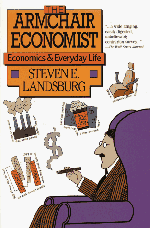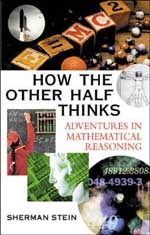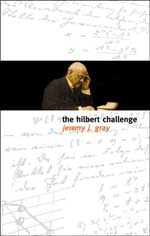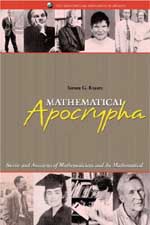Reviews and recommendations
'Mathematics for the imagination'I have never before read a book that has so frequently made me think "wow, that's interesting!". "Mathematics for the Imagination" is an absolutely fascinating account of mathematical methods and discoveries and the people behind them, with the sordid histories of mathematicians through the ages jostling for the reader's attention next to their elegantly simple proofs.
'The armchair economist'"Economic theory predicts that you are not enjoying this book as much as you thought you would", remarks Steven E. Landsburg at the start of one of the most enjoyable chapters of The Armchair Economist. The point turns out to be this: the fact that you have chosen to read it is a sign that you have probably overvalued it in relation to all the other books you could have read instead.
'How to lie with statistics'Although this book is 50 years old this year, its wisdom is needed now more than ever, as increasing computer power and our headline-obsessed media look set to drown us all in a sea of "statisticulation". This is the word coined by Darrell Huff to describe misinformation by the use of statistical material. Biased samples, dubious graphs, semi-attached figures: he describes all the usual suspects clearly and simply, rounding off with the most useful topic of all: How to Talk Back to a Statistic.
'Towing icebergs, falling dominoes'We live in a world that obeys many physical laws, and that can be modelled by a variety of mathematics. It is surprising what a variety of problems can be described by very similar models. Robert B. Banks does not concentrate on the most common examples of applied mathematics, but instead covers a fascinating selection of topics as varied as the US national debt, the Eiffel Tower, and the flight of golf balls.
'How the other half thinks'Most people think that mathematics consists of either just arithmetic, or a collection of very abstract and technical topics which the layperson has no chance of grasping. But this really is not true: of course many areas are too technical for the non-mathematician, but there are also many beautiful and non-trivial facts which can be expressed in ordinary language for everyone to appreciate.
'The Hilbert challenge'"As long as a branch of science offers an abundance of problems", proclaimed David Hilbert, "so is it alive". These words were delivered in the German mathematician's famous speech at the 1900 International Congress of Mathematics. He subsequently went on to describe 23 problems which he believed would spur on mathematical thought for the upcoming century.
'Mathematical apocrypha'"Mathematical Apocrypha" is, as its subtitle intimates, a book of stories and anecdotes about mathematicians and the mathematical. However, in contrast with many books about mathematicians, Steven Krantz focuses on contemporary figures such as Wiener, Littlewood and Hardy, and says very little about the usual myths regarding Pythagoras, Descartes or Euler.
'Dicing with death'"Dicing with Death" is a rarity: a book about statistics for the general public. Popular maths books are no longer uncommon, popular books on the physical sciences became a publishing phenomenon with Stephen Hawking, but popular statistics books are few and far between. Perhaps this fact is related to the poor public image of statistics, although it is difficult to say which is cause and which effect.
'A mathematician plays the market'John Allen Paulos is the man who popularised the word "innumeracy", meaning the all-too-common condition of ignorance and bewilderment about maths and numbers in general. A light, cheerful and ever-so-slightly smug look at the problem, his best-known book of the same name (reviewed in Issue 11 of Plus) traces the roots of innumeracy to poor teaching and offers suggestions for antidotes and innoculation.
'Strange curves, counting rabbits'Are you interested in maths just for the fun of it? Or does mathematics seem irrelevant? Either way, this book is for you. Keith Ball is eager to share with his readers the way some of the numbers around us in the world work, and their uses.
'Isaac Newton'In this well-written book, James Gleick (author of Chaos) tackles the life and work of Isaac Newton. He focuses on the man and his life in the historical context of Britain in the 17th Century, and, although the book is not a light read, he explains Newton's science well without the use of any equations.
Newton was born in 1642 in the time of the civil war (King Charles was beheaded when Newton was six years old).
'Gamma'Of all the classical functions, the Gamma function still retains much of its mystery and intrigue, since Euler first spotted it as something "worthy of serious consideration". In Gamma, Julian Havil explores Gamma from its birth and in so doing simultaneously deals with many related functions, problems and issues that go beyond the conventional territory of functions alone.











